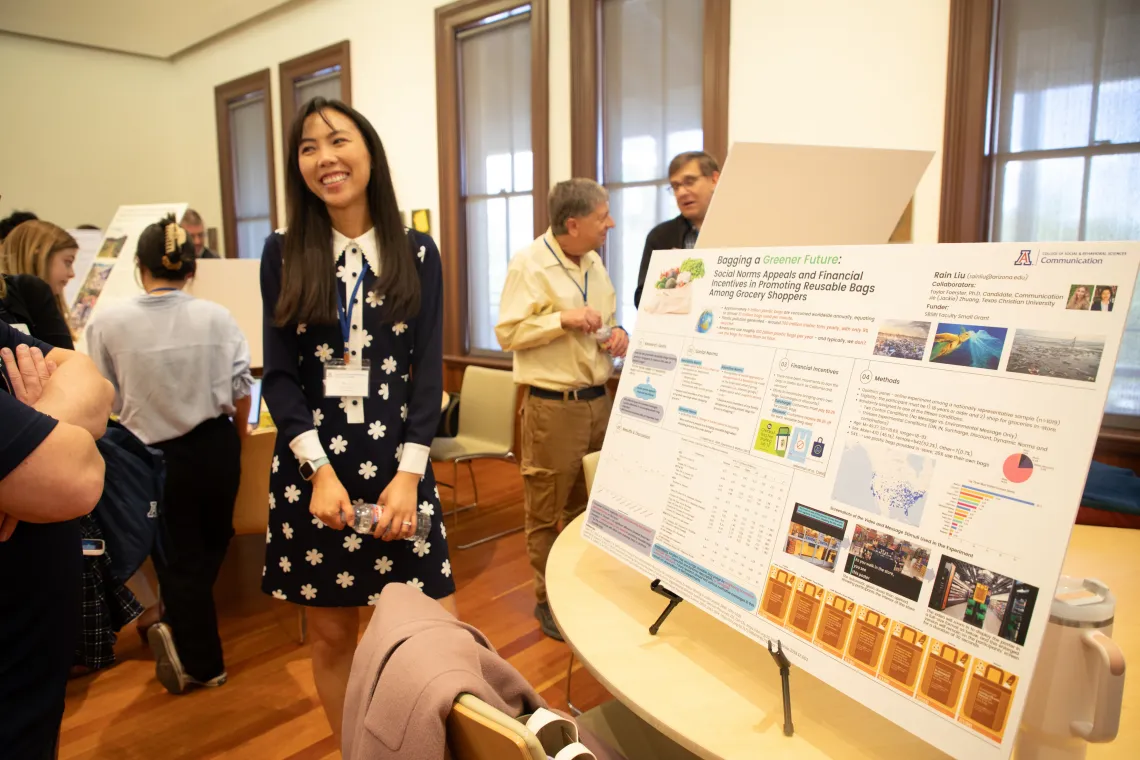Social Norm Messages Significantly Affect People's Intention to Reduce Food Waste

Rain Liu at the SBSRI Research Showcase, 2024.
Rain Liu, an assistant professor in the Department of Communication in the College of Social and Behavioral Sciences, received her Ph.D. in communication studies from Michigan State University. Liu’s experience in grant-funded research has been featured in multiple academic journals, earning her various awards. Currently, she teaches classes in public relations, intercultural communication, persuasion, research methods, and communication/PR campaign design and analysis.
One of Liu’s main areas of interest is social norms and how they influence behavior, particularly concerning food waste — a global issue with significant environmental and social impacts.
Liu became interested in food waste while her boyfriend, now husband, was working in the dining hall at Michigan State. She was shocked to learn how much food was discarded daily. This curiosity evolved into a research project examining how social norms affect people’s intentions to reduce food waste.

In a recent study analyzing the behaviors of college students in both the United States and China, Liu explored whether cultural context influences how people respond to social norm messages. Social norm messages, such as those indicating that food waste is common (descriptive norms) or that preventing food waste is socially approved (injunctive norms), can significantly impact people’s intentions.
“The key takeaway is that communication strategies addressing issues like food waste need to be culturally grounded to maximize their impact,” Liu explained.
To test her hypothesis, Liu and her co-author, who was also her doctoral advisor, presented participants with messages that framed food waste as common or socially approved among their important social groups. They then measured the participants’ intentions to reduce food waste.
“Our goal was to see how these messages influenced participants' intentions and how cultural context and group orientation shaped these effects,” Liu said.
Her results revealed intriguing cultural differences.
Chinese participants viewed food waste as a more socially approved behavior than U.S. students did, leading to stronger intentions to reduce food waste among the Chinese students. Liu found that group orientation also played a role, as participants from both cultures were influenced by how embedded they felt in their social groups.
Liu noted a growing interest in social norms research, particularly in how these norms work across cultures.
“I’ve always been fascinated by the role social norms play in shaping behavior, but I noticed a gap in understanding how these norms operate across different cultures,” she said.
This study aims to address this research gap in cross-cultural communication strategies. Liu’s findings suggest that cultural factors significantly shape the effectiveness of norm-based communication strategies.
“In collectivist cultures, discussing how common a behavior is may be more effective, while in individualistic cultures, focusing on personal responsibility might yield better results,” Liu noted.
Liu’s research provides practical insights.
Through her work, she hopes to inspire more culturally informed communication strategies that not only address food waste but also potentially tackle other environmental challenges like plastic reduction and climate change.
“In our daily lives, if we want to encourage behavior change,” Liu said, “whether it’s reducing food waste or promoting other prosocial behaviors, we should consider the cultural backgrounds and established norms of the people we’re communicating with.”
##

